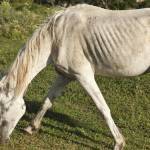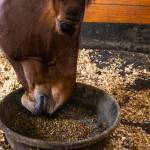Refeeding Malnourished Horses

Few sights are more tragic than malnourished or starved horses. Outright neglect does occur, but not all underweight horses are victims of abuse. Horses may have or be recovering from serious conditions that have led to weight loss, and their owners are doing all they can to help the horse regain its previous condition. Others are being fed regularly but the feed may be of poor nutritional quality. Understanding the effects of starvation, the likelihood for recovery, and basic principles of refeeding will help horse owners should they encounter a horse that requires a nutritional overhaul.
Effects of Starvation
Starvation causes muscle wastage, weakness and hypothermia, and decreases gastrointestinal function, wound healing, cold tolerance, and immunity. Pregnant mares, nursing foals, or heavily parasitized horses will be further compromised. When feed intake is decreased, the horse first relies on its body stores of energy in the form of glycogen and fat. Glycogen is a large highly branched sugar (glucose) that is primarily stored in the liver and muscle. Glycogen stores are depleted fairly quickly when feed is restricted, usually within 24-36 hours, and the horse will then begin to use its fat stores. The horse will eventually run out of stored energy sources and will begin to break down its own proteins (such as muscle) to produce glucose. It takes about 60-90 days of feed deprivation for a normal, healthy horse in moderate body condition to drop enough weight to lose its ability to remain standing.
Starved horses have decreased gut bacteria and protozoa populations that are essential to ferment forages and other feeds. Additionally, the gut cells that produce digestive enzymes have decreased ability to digest and absorb feed. For these reasons, digestibility of feed is reduced. Refeeding must occur gradually to allow the gut flora to readapt to feed and recover their normal functions.
Prognosis
Horses that have been unable to stand for 72 hours or more have a poor prognosis for recovery, even with aggressive treatment. As a general rule, the longer a horse is down, the more guarded the prognosis. Horses that initially are able to stand and subsequently become recumbent and unable to rise are unlikely to be saved, as are horses that have lost 45-50% of their body weight.
Refeeding Syndrome
When refeeding malnourished horses, caretakers must overcome the impulse to immediately feed them whatever and however much they want. Months of neglect cannot be undone in a few days or weeks. Overfeeding malnourished horses can cause much harm and potentially death.
Refeeding syndrome has been recognized in starved humans and animals when they regain access to food. During starvation, body reserves of fat and protein are used for energy. Likewise, electrolyte and mineral stores, especially phosphorus, decrease. Whenever the animal eats again, insulin is released in response to increased blood glucose, and stimulates protein synthesis and movement of electrolytes and glucose into cells. This shift of electrolytes results in low blood concentrations of phosphorus, magnesium, and potassium. Phosphorus is needed for energy production in the cells and for delivery of oxygen by red blood cells. Swelling of the legs and bottom of the chest and abdomen occurs due to low blood protein and retention of sodium and water.
Refeeding syndrome can result in neurologic signs or death due to cardiac and pulmonary failure. Feeding large amounts of carbohydrates before the horse’s gut flora have had time to adapt can also result in colic, diarrhea, and laminitis.
Initial Refeeding
Starved horses should be fed at 50% or less of their current (poor body condition) energy requirements. Concentrate feeds (pellets and grain) should be avoided for the first 2-3 days. Feedings should be small (one-quarter to one-half flake of hay) and given every 4-6 hours to better allow the digestive tract to adapt to refeeding. The best initial feed is usually good quality grass hay. Mature grass hay or oat hay can be too bulky and low in energy for horses to consume sufficient energy to gain weight.
Some veterinarians recommend alfalfa (lucerne) hay because it is higher in minerals and protein than grass hay. However, some refeeding trials demonstrated that horses fed alfalfa had lower weight gains and an increased chance of gastrointestinal problems. Horses can also be turned out onto pasture for 2-3 hours, and grazing time can be gradually increased by an hour every 2-3 days. Horses should have access to or be fed mineral and vitamin supplements or balancer pellets.
Vitamins and minerals should be fed according to the manufacturer’s label to avoid toxicity problems. Some nutritionists also recommend supplementation of B vitamins because they are important for energy metabolism, and many are produced by gut bacteria. Supplemental thiamine (vitamin B1) may be beneficial to prevent refeeding syndrome. Clean water should be available at all times. Probiotics or prebiotics are generally safe for animals with healthy immune systems and can be administered to repopulate the gut and aid digestion.
It is important to keep thin horses protected from the rain, snow, wind, and cold because their ability to tolerate cold and generate body heat is impaired. Feeding additional hay will create more body heat when it is fermented in the large intestine. Horses that have long winter coats in the warmer seasons will likely need to be washed and groomed to avoid heat stress as their metabolic rates increase.
Refeeding After the Adaptation Period
After 2-3 days of feeding, the horse can be fed to meet the requirements of its present (but low) body weight for another 2-3 days. Once the horse has adjusted to feed intake and its gastrointestinal tract has adapted, the amount of feed can be increased over 7-10 days to meet requirements for its ideal body weight. The number of meals fed can be gradually reduced to 2-3 per day as the horse is able to eat more. It is not unusual for some diarrhea to occur with refeeding. Normally, the diarrhea is fairly mild and resolves without any treatment as long as the horse does not become dehydrated or have an infectious disease.
Nonstructural carbohydrates (NSC or highly digestible sugars) such as those found in concentrates should be less than 20% of the diet. Most grass or legume hays will be less than 15% NSC. Alfalfa (lucerne) is an excellent source of protein and minerals, but horses should be gradually transitioned to it. Horses may do better when fed grass hay initially, and alfalfa (lucerne) can be slowly introduced into the ration later. If green pasture is available, then the horse can be turned out for a few hours per day. Grazing time can be gradually increased every 2-3 days.
Complete pelleted feeds that do not have a high grain content, such as alfalfa pellets, work well for concentrate feeding. Senior feeds are also commonly used and they typically have adequate fiber and increased vitamin and mineral concentrations. Most adult-sized horses can be started with ½ pound (0.2 kilogram) of pellets twice a day and this amount can be gradually increased every 2-3 days as needed. Mature horses in light work require only about 8% protein in their diet. Additional protein is required when refeeding starved horses because they need protein above their maintenance requirement to repair and build muscle.
Some veterinarians recommend corn oil because it is higher in calories than carbohydrates. Starved horses will lack normal enzymes and the ability to digest fats and other nutrients. Some horses will also stop eating when fed large amounts of fat. For these reasons, it is recommended to allow the horse 10-14 days to adapt to refeeding before supplementing fat for additional calories. Fats are also probably best used for horses that do not seem to be gaining weight as expected with increasing amounts of feed. Rice bran and feeds intended for performance or senior horses will contain additional fat. Corn oil can be added to the concentrate portion of the diet beginning at ½ cup twice a day. Most horses will eat this amount, and it can be gradually increased up to 1 cup twice a day over a 2-week period.
Transition Back to Normal Weight
The transition back to normal body weight should be gradual to minimize the chances of adverse gastrointestinal effects and laminitis. Moderately starved and thin horses usually regain body weight within 60-90 days. However, severely starved horses may take 6-10 months. Once the horse has adapted to refeeding over about 2 weeks, then feeding can be increased to meet the requirements for its ideal weight. Horses should have free-choice access to pasture or good-quality hay. Feeding is increased to meet requirements for the horse’s current body weight plus the weight that it needs to gain back.
For example, if the horse weighs 750 pounds (350 kg) and should weigh 1000 pounds (450 kg), then its feed should be gradually increased to meet the needs of a 1250-pound (500-kg) horse. Mares that are lactating or in the last 3 months of pregnancy will also have higher nutritional requirements. If malnourished horses appear to not gain weight as expected, they should be examined by a veterinarian to determine if any underlying disease or parasitism may be complicating or preventing recovery.
The horse should be allowed turnout as much as possible if it has no health or lameness problems that would prevent normal exercise. If the horse can be ridden, it should have gained back most of its weight before mounted exercise to ensure adequate muscling for work and to prevent tack rubs. Prior to any riding or exercise program, the horse should be examined by a veterinarian to rule out any musculoskeletal or other medical problems such as heaves or heart disease.
The veterinarian and nutritionist who have examined your horse and are familiar with your farm are the best sources of information concerning refeeding of malnourished horses.








